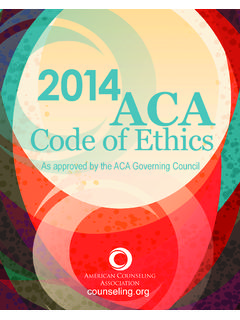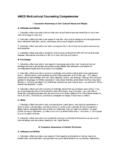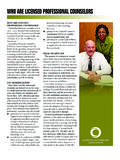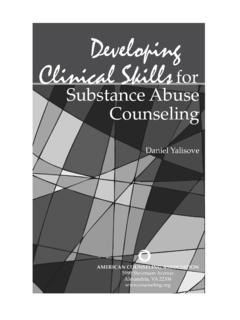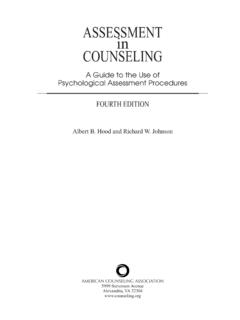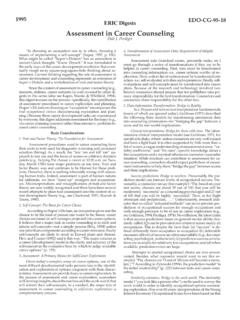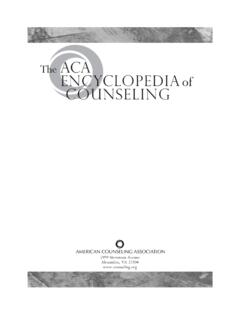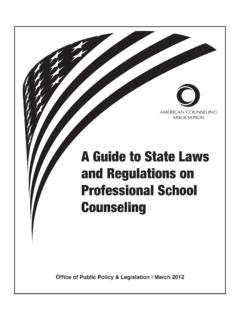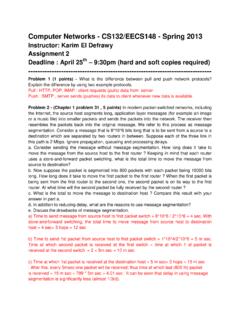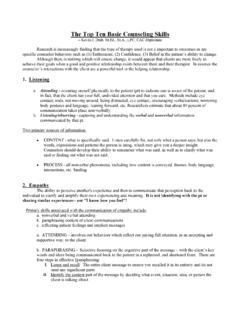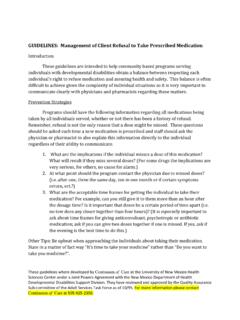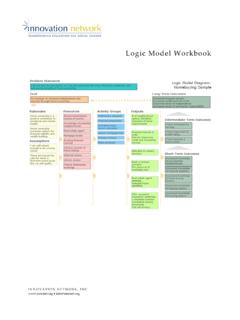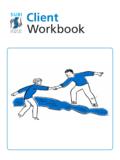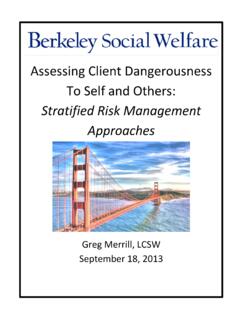Transcription of Addressing Client Resistance: Recognizing and Processing In …
1 VISTAS Online is an innovative publication produced for the American Counseling Association by Dr. Garry R. Walz and Dr. Jeanne C. Bleuer of Counseling Outfitters, LLC. Its purpose is to provide a means of capturing the ideas, information and experiences generated by the annual ACA Conference and selected ACA Division Conferences. Papers on a program or practice that has been validated through research or experience may also be submitted. This digital collection of peer-reviewed articles is authored by counselors, for counselors. VISTAS Online contains the full text of over 500 proprietary counseling articles published from 2004 to present. VISTAS articles and ACA Digests are located in the ACA Online Library. To access the ACA Online Library, go to and scroll down to the LIBRARY tab on the left of the Under the Start Your Search Now box, you may search by author, title and key The ACA Online Library is a member s only benefit.
2 You can join today via the web: and via the phone: 800-347-6647 is commissioned by and is property of the American Counseling Association, 5999 Stevenson Avenue, Alexandria, VA 22304. No part of Vistas may be reproduced without express permission of the American Counseling Association. All rights ACA at: VISTAS OnlineAddressing Client Resistance: Recognizing and Processing In-Session Occurrences VISTAS 2006 OnlineAddressing Client Resistance: Recognizing and Processing In-Session Occurrences Joshua C. WatsonMississippi StateUniversity Meridian Campus Joshua C. Watson, is an assistant professor of Counselor Education at the Mississippi State University Meridian campus. His research interests include the effects of Client variables on positive counseling outcomes. Dr. Watson can be reached by E-mail at The practice of professional counseling seldom follows the prescribed approaches exactly as they are taught in most counselor training programs.
3 Occasionally, despite a counselor s best efforts, some clients fail to act in their best interests and negatively respond to all counseling interventions. file:///C|/counseling%20 (1 of 14) [8/12/2006 10:21:52 AM] Addressing Client Resistance: Recognizing and Processing In-Session Occurrences These clients are often called oppositional, reactionary, noncompliant, intractable, and unmotivated (Dowd, 1989). The behaviors displayed by these difficult clients are often collectively referred to as resistance. In clinical terms, resistance is defined as a process of avoiding or diminishing the self-disclosing communication requested by the interviewer because of its capacity to make the interviewee uncomfortable or anxious (Pope, 1979, p. 74). It is an active process that has the potential to become a fundamental obstacle to positive counseling outcomes. Resistance interferes with the counselor s perceived efficacy, impedes Client motivation, and undermines the change process (Nystul, 2001).
4 The purpose of this paper is to reframe the concept of resistance as a critical incident in the counseling process with the potential to positively affect counseling outcomes. It is important for counselors to recognize the expectations clients have toward seeking counseling for the first time. For many, the counseling process might seem quite daunting. Unsure of what to expect, clients are asked to enter into a working relationship built on trust and intimacy with an individual they have just met for the first time. They must be ready to explore personal issues they might not have shared previously with even their closest friends and family. For other clients , the choice to seek file:///C|/counseling%20 (2 of 14) [8/12/2006 10:21:52 AM] Addressing Client Resistance: Recognizing and Processing In-Session Occurrences counseling help might not have been their own. They may have been coerced into treatment, and as a result they are not willing to fully commit themselves to the process.
5 Given the unique dimensions of the counseling process it is only natural that some clients feel a sense of resistance toward the counseling process. Counselors would be wise to acknowledge this resistance as evidenced by the fact that over 400 theories of counseling and psychotherapy acknowledge resistance as a common therapeutic experience and Client response. An understanding of how resistance is conceptualized in various theoretical frameworks may help the counselor better understand the reasons behind a Client s difficult demeanor during the counseling process. Early views of resistance focused on its role as an individual defense mechanism. As the dominant theoretical framework of the early 1900s, psychoanalysis was the first approach to include the term resistance. In psychoanalytic terms, resistance is the Client s attempt to block or repress anxiety-provoking memories and insights from entering conscious awareness.
6 Building on the psychoanalytic view, individual psychologists saw Client resistance as a self-protective and adaptive process that functioned to preserve core attitudes about the self, others, and life. In both file:///C|/counseling%20 (3 of 14) [8/12/2006 10:21:52 AM] Addressing Client Resistance: Recognizing and Processing In-Session Occurrences of these approaches resistance occurred at an unconscious cognitive level. In contrast to these early approaches, behavioral theorists view resistance simply as Client noncompliance. Behaviorists believe that a Client exhibits resistant behaviors because he/she (a) lacks the necessary skills or knowledge needed to follow behavioral assignments, (b) have negative expectations or beliefs regarding their counseling outcomes, and (c) are subject to undesirable environmental conditions (Shelton & Levy, 1981). Ultimately, the Client s resistance is seen as an obstruction or obstacle to successful goal attainment.
7 The 1940s and 1950s saw the development of the existential and Client -centered approaches and subsequently the view of resistance changed. In these humanistic approaches, resistance is conceptualized as the avoidance of unpleasant or dangerous feelings that may become permanent blocks to awareness and impair holistic functioning. clients are reluctant to engage in any process that might negatively alter their life scripts. Allowing negative feelings to enter into consciousness could diminish an individual s self-efficacy and self-concept. Modern theories approach Client resistance from a systems perspective. file:///C|/counseling%20 (4 of 14) [8/12/2006 10:21:52 AM] Addressing Client Resistance: Recognizing and Processing In-Session Occurrences The family systems theorists view resistance as an unconscious attempt to protect other family members by avoiding any disturbance to the delicate homeostatic balance of the system in which change and growth have unconsciously become associated with disloyalty, betrayal, and loss.
8 clients become reluctant to change their beliefs or behaviors for fear that doing so will negatively impact other family members. While these changes might be in their best interests, clients place the family s welfare ahead of their own. Conceptualizing Resistant BehaviorsDespite the fact that the varying theories describe Client resistance in different terms, there are many similarities in what are the qualities and characteristics of a resistant Client . One of the first attempts to systematically examine Client resistance, Otani (1989) classified resistant Client behaviors into separate categories. These categories include several verbal and nonverbal Client behaviors that are cognitive and behavioral in nature. The four categories described by Otani are response quantity, response content, response style, and logistic management. Response quantity resistance file:///C|/counseling%20 (5 of 14) [8/12/2006 10:21:52 AM] Addressing Client Resistance: Recognizing and Processing In-Session Occurrences Response quantity resistance is viewed as the Client s noncompliance with the change process.
9 This category consists of a class of behaviors whereby the Client limits the amount of information communicated to the counselor. Silence and minimal talk are typical forms of resistance in this category. Otani (1989) identified such behaviors as frequent pauses, taciturnity, silence, and minimal talk as signs that the Client may be engaging in this type of resistant behavior. By limiting the amount of information they give to the counselor, clients are able to control the counseling session and prevent the discussion of difficult or emotionally painful topics. This behavior is observed most frequently among involuntary clients , such as court-referred clients (Dyer & Vriend, 1988). Response content resistanceResponse content resistance is a Client s attempt to restrict or control the type of information communicated to the counselor. This may manifest itself in several different forms.
10 Often times, clients engage in small talk about irrelevant topics, such as gossip or rumors. clients may engage in intellectual talk by repeatedly using technical terms and abstract concepts during the counseling session. There may be an emotional display ( , anger outburst, crying) in reaction to a counseling topic. clients may ask a series of meaningless questions about counseling techniques or theories file:///C|/counseling%20 (6 of 14) [8/12/2006 10:21:52 AM] Addressing Client Resistance: Recognizing and Processing In-Session Occurrences that have no relevance to the issue currently being discussed. They also may ruminate about physical problems or past mistakes or show a preoccupation with past events. These forms of Client resistance block the counselor- Client communication by manipulating the kind of information to be shared with the counselor. As a result, counselors are unable to gain a firm grasp on the nature of the Client s problems, making case conceptualization cumbersome.

